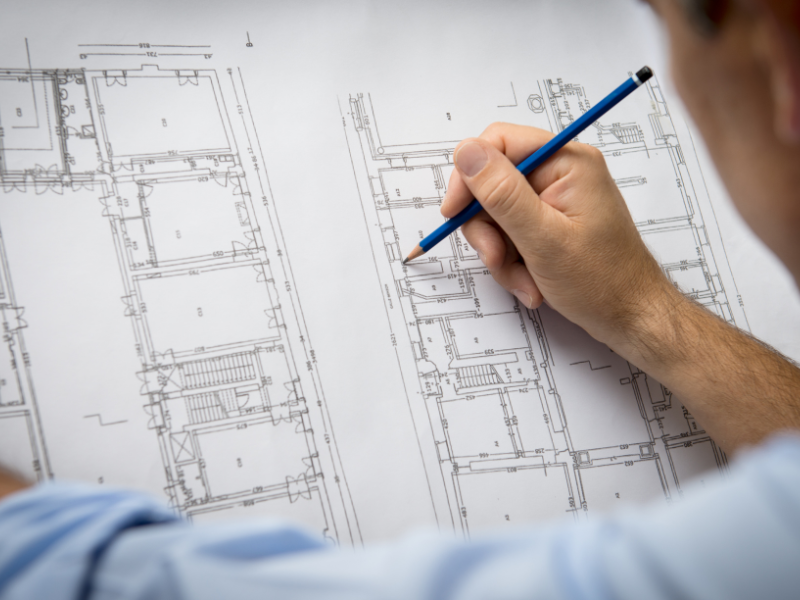Architect Rules for Designing Evergreen Interiors
Architect Rules for Designing Evergreen Interiors
Blog Article
Comprehending the Diverse Occupation Paths Available for Aspiring Architect
As an aspiring Architect, you have a globe of occupation paths waiting for you. Whether you're attracted to typical design or the nuances of lasting layout, there's a specific niche that aligns with your rate of interests.
Typical Style: Designing Structures and Frameworks
Conventional architecture concentrates on developing structures and structures that mix performance with aesthetic charm. As you explore this area, you'll appreciate the complex balance in between form and objective. You'll learn to attract inspiration from historical designs, incorporating aspects like symmetry, materials, and workmanship. Your designs can show social heritage, showcasing regional practices while meeting modern-day needs.
You'll create skills in drafting, model-making, and site evaluation, allowing you to imagine and connect your concepts properly. Engaging with clients, you'll need to comprehend their vision and equate it right into possible designs.
Additionally, constructing codes and sustainability practices are essential in your job, guaranteeing your frameworks are ecologically pleasant and risk-free. As you expand in your job, you'll locate possibilities in household, commercial, or even remediation jobs, each offering special obstacles. Welcoming typical style leads the means for a meeting occupation that admires the past while forming the future.
Urban Preparation: Shaping Communities and Public Spaces
As an aspiring Architect, you can play an important role as an urban planner, changing exactly how neighborhoods work and communicate. By using area involvement approaches, you'll guarantee that locals have a voice fit their environment. And also, integrating sustainable design concepts will certainly help create areas that not only fulfill today's requirements however additionally shield the future.
Role of Urban Planners
While lots of could think of designers as the sole enthusiasts behind structures, city organizers play a necessary duty in forming the wider landscape of areas and public rooms. By collaborating with various stakeholders, you'll help develop parks, transportation systems, and domestic areas that promote social interaction and availability. Your expertise in spatial design and community dynamics allows you to envision future development while maintaining social heritage.
Area Interaction Methods
Efficient neighborhood interaction techniques are vital for urban organizers to assure that the voices of citizens are heard and valued in the planning procedure. To promote significant dialogue, you need to focus on open forums and workshops where community participants can reveal their ideas and problems. Use surveys and social media sites to reach a broader target market, making sure diverse viewpoints are included. Collaborating with neighborhood organizations can enhance trust fund and assist in deeper links. It is very important to provide clear info about decision-making procedures and proposed tasks, enabling residents to feel educated and encouraged. By actively paying attention and integrating responses, you'll create rooms that reflect the neighborhood's needs, eventually leading to even more effective and sustainable urban atmospheres. Welcome transparency and constant discussion for long lasting effect.
Sustainable Style Principles
When creating metropolitan spaces, incorporating lasting style principles is important for producing atmospheres that prosper both environmentally and socially. You must start by concentrating on power performance, making use of products that minimize waste and promote recycling. Think about integrating green spaces, like yards and parks, to improve biodiversity and enhance air quality. Promoting walkability and public transportation can lessen reliance on automobiles, promoting a healthier area.
Designing with water preservation in mind is likewise vital-- consider rainfall gardens and absorptive surfaces to take care of stormwater. Including area members throughout the planning procedure warranties that the areas you create satisfy their needs and motivate social interaction. By accepting these concepts, you'll add to vivid, sustainable metropolitan landscapes that profit everybody.

Landscape Style: Creating Sustainable Outside Settings
As you explore landscape architecture, you'll find crucial design principles that produce practical and attractive outdoor spaces. Sustainable methods play a crucial duty in making certain these environments flourish while reducing ecological effect. And also, you'll locate a selection of job opportunities that allow you to make a real difference in how people interact with nature.
Design Concepts in Landscape
Understanding style principles in landscape architecture is crucial for creating lasting exterior settings that balance with nature. You'll require to consider elements like equilibrium, scale, and percentage to guarantee your layouts really feel cohesive and welcoming. Integrating native plants not just boosts biodiversity however likewise reduces water use, making your landscape durable. Think of the circulation of area and how individuals communicate with it; pathways and seating locations must invite expedition and relaxation. Additionally, focus on seasonal modifications, designing with products that match the environments year-round (Architect). By focusing on sustainability and looks, you can create outdoor rooms that enrich the area and promote well-being. Welcoming these principles will certainly set a solid foundation for your occupation in landscape architecture.
Lasting Practices Overview
Sustainable techniques in landscape architecture not only concentrate on visual appeals however additionally focus on ecological health and resource conservation. By incorporating indigenous pop over here plants, you boost biodiversity and reduce the need for chemical fertilizers and pesticides. Carrying out reliable watering systems aids preserve water and decreases runoff, protecting nearby communities. You can create areas that advertise dirt health and wellness, such as practicing and using organic products permaculture concepts. In addition, including environment-friendly framework, like rainfall yards and porous pavements, aids in stormwater monitoring and lowers city heat. When you develop outdoor settings with sustainability in mind, you contribute to a much healthier earth and give areas that promote community connection. Ultimately, these techniques guarantee your layouts benefit both people and the setting for many years to come.
Career Opportunities Exploration
With a solid structure in sustainable methods, landscape design uses a selection of career paths that allow you to make a significant effect on the environment. Urban coordinators usually collaborate with landscape engineers to develop green spaces in metropolitan settings, enhancing city livability. If you're enthusiastic concerning education and learning, think about becoming a landscape architecture instructor, inspiring future generations.
Sustainable Layout: Concentrating On Eco-Friendly Practices
As you explore your career in style, accepting green methods can set you apart in an affordable field. Sustainable layout focuses on creating structures that lessen environmental influence while improving occupant wellness. By incorporating eco-friendly materials, energy-efficient systems, and lasting building strategies, you'll add to a greener future.
Beginning by acquiring expertise of eco-friendly certifications like LEED or BREEAM, which can boost your credentials. Think about just how natural light, air flow, and thermal efficiency can maximize design. Work together with designers and environmental professionals to innovate remedies that decrease waste and save sources.
Do not fail to remember the importance of area involvement-- engaging local stakeholders can inspire layouts that harmonize with the atmosphere. As customers significantly prioritize sustainability, your knowledge in environment-friendly practices will not just attract jobs yet additionally fulfill your enthusiasm for accountable design. Welcome this crucial aspect of the occupation, and enjoy your occupation prosper.
Historical Conservation: Protecting and Restoring Cultural Heritage
While you begin on your architectural journey, think about the necessary duty of historical conservation in keeping our social heritage. This area focuses on the security and remediation of considerable buildings, sites, and structures that inform the tales of our past. By participating in historic preservation, you'll help safeguard the building tradition that shapes community identification.
As a historic conservation Architect, you'll assess historical significance and examine the condition of frameworks. You'll function carefully with guardians and chroniclers to guarantee genuine remediation strategies are employed. This occupation course enables you to mix imagination with study, enabling you to create solutions that appreciate initial products and craftsmanship.
Your work not just contributes to sustainability by reusing existing structures yet additionally cultivates a sense of pride within communities. Welcoming this path will certainly help you come to be a guardian of background, preserving the stories and visual appeals that enhance our lives.
Inside Style: Enhancing Indoor Spaces
Historic preservation and interior design both share a dedication to boosting the built environment, but they concentrate on various facets. While historical conservation highlights keeping a framework's historic and social worth, indoor style absolutely nos in on optimizing indoor areas for performance and appearances.
As an ambitious Architect, you'll locate that indoor style permits you to mix creative thinking with technological abilities. You'll create areas that not only look great but also promote convenience and performance. This area includes comprehending how light, color, and products connect within a room, impacting mood and usability.
You'll work on various projects, from residential homes to business workplaces, making sure that each environment meets the demands of its passengers. By prioritizing customer experience, you can transform insides right into inspiring and functional areas, making a substantial influence on exactly how individuals engage with their surroundings. Welcome the chance to enhance interior atmospheres and form the method people work and live.
Industrial Layout: Merging Capability With Appearances
Industrial layout plays a necessary function in developing products that flawlessly blend aesthetics go to this website with performance, ensuring that what you utilize daily is not only aesthetically appealing yet also practical. As a hopeful Architect, you can immerse on your own in this area, focusing on creating everything from furniture to customer electronic devices. Your work includes recognizing user requirements, products, and making processes, enabling you to develop innovative services that improve day-to-day experiences.
In industrial layout, you'll usually team up with designers, makers, and online marketers, ensuring that your styles are not only lovely but additionally possible. This job path uses a dynamic atmosphere where creative thinking satisfies usefulness, making it a gratifying selection for architects interested in shaping the items of tomorrow.
Frequently Asked Concerns
What Educational Certifications Do I Need to End Up Being an Engineer?
To become an architect, you'll require a specialist degree in architecture, normally a Bachelor's or Master's. Additionally, you'll have to complete a teaching fellowship and pass the Architect Enrollment Examination to practice lawfully.
Exist Qualification Requirements for Different Architectural Career Paths?
Yes, there're qualification needs for various architectural paths. Architect. You'll need to pass exams, total teaching fellowships, and often seek specialized training, try this relying on your picked emphasis, like landscape style, city layout, or historical conservation
What Software Abilities Are Essential for Architects Today?

Exactly How Can I Gain Practical Experience While Studying Style?
You can gain practical experience by interning at building firms, taking part in style competitions, offering for neighborhood projects, or teaming up with schoolmates on real-world assignments. These possibilities improve your abilities and develop valuable links in the industry.
What Work Opportunities Exist Outside Standard Architecture Firms?
You can discover various task opportunities outside standard architecture companies, like city planning, indoor design, landscape design, building and construction administration, property development, or perhaps roles in sustainability consulting. Each offers one-of-a-kind challenges and benefits.
Whether you're attracted to traditional design or the subtleties of sustainable style, there's a particular niche that aligns with your rate of interests.When making urban spaces, integrating lasting design principles is crucial for developing atmospheres that flourish both environmentally and socially.As you check out landscape architecture, you'll uncover necessary layout concepts that create useful and beautiful outdoor areas.Comprehending layout concepts in landscape style is essential for creating sustainable outdoor environments that harmonize with nature.In industrial design, you'll typically work together with manufacturers, marketers, and designers, making certain that your layouts are not only stunning but also viable.
Report this page